Wireless Device
-
- Cyber World: Safer Seas via Phantom Ships Maritime Reporter, Jan 2016 #20
Are we that far away from phantom fully autonomous vessels plying the world’s seas? Not according to many in the know. Many predict by 2020 that we will see this type of ship with a limited crew in smaller applications such as the marine highway short haul scenarios, local ferry service such as the Staten Island ferry and offshore supply boats in the Gulf of Mexico.
Phantom/drone unmanned ships reportedly would be safer, cheaper and less polluting for an industry that carries approximately 90 percent of the world trade. However as with aircraft drones and on the horizon driverless auto’s, we must be concerned with regulatory and safety issues. Of utmost importance is the safety factor as in most industries it fundamentally comes down to human or “pilot error.” So if we can remove the mariner from the equation we have in theory made the shipping industry safer. This factor along with the reduction in cost of crewing and finding competent mariners may make this option much more viable to shipping companies on the fence.
These sudden advances in technology will also bring with them the potential for intrusions via the cyber world so we must stay ever vigilant and “install plan by design measures” to thwart these potential infiltrations. When we contemplate cybercrime and security many individuals think in a narrow focus of the hacking recently of the OPM database and the theft of personnel data as well as the Target chain credit card breach.
From a recent conference I attended in Brest, France it was indicated that cyber threats can come from three sources: internal, external, and sabotage/espionage. It was noted that external threats get the most publicity and news but that internal threats had the potential for being the most-costly and severe. Each of these threat categories brings with it specific factors that must be addressed by the maritime community as we move forward in our quest to unmanned vessels. This paradox has taken on a new meaning as we take leaps and bounds to compete with other industries that are successfully using autonomous technology. These include aviation with drones and now automotive with Apple, Google and Tesla in the lead to be the first with a fully automated hands off the wheel automobile. It truly is becoming a science fiction movie in a “Future World”.
How do we in the maritime and shipping industry stay ahead of the curve and plan for success when we fully do not have a solid grasp of the magnitude of cyber threats and crime banging on our portholes?
Although the technology is there many have not fully embraced it from both an evolutionary and defensive posture and much needs to be done before it can be fully implemented or combatted. If we do not move quickly the potential for a catastrophic event with major consequences increases proportionately.
Of utmost importance as we move forward in the autonomous world is the development of safeguards to Industrial Control Systems (ICS’s) aboard vessels. This will be the primary intrusion mechanism for cyber-attacks via unauthorized access to the vessels control systems and networks utilizing communication channels. Predominantly this will be accomplished via remote Radio Frequency (RF) interception unless the attack occurs on the vessel, most likely through a USB port or a serial port.
Intangible is a key word to look at in the wireless world as every wireless device is simplistically a radio that is constantly sending and receiving data and signals. This makes them and all shipboard systems that require these transmissions extremely vulnerable. A prime example of this vulnerability was the recent University of Texas GPS spoofing of a luxury yacht in the Gulf of Mexico. Researchers, relatively easily with minimal cost, were able to divert this yacht off its intended track with no alarms being sounded. It was truly a remarkable feat with little fanfare. Imagine if a hacker had done this to a commercial vessel coming into New York Harbor? Or what about a hacker getting into the ECDIS chart database and moving one buoy that could put a vessel at jeopardy of going aground or worse.
In our current cyber world these electromagnetic anomalies allow every onboard device that can receive these signals whether the GPS, AIS, ECDIS or a PLC to be a potential source and gateway for cyber criminals to connect to the ships systems. Once inside the device or network, the hackers have the ability to do plenty of damage.
Another area of significant importance is the use and control aboard vessels of Programmable Logic Controllers (PLC’s). Most non-technical personnel are not aware that a PLC is a type of computer that controls most devices and equipment in today’s world. Not only does it control the equipment, it also troubleshoots it and acts as the brain of the device. This maybe the Pandora’s box or Achilles’ heel of the PLC as it is the back door for someone to get in and control your equipment. Engineers use remote PC’s to access the PLC to perform maintenance and troubleshoot the equipment.
Research and a recent survey have shown that a typical ship can have anywhere up to 36 PLC’s onboard. It provides the opportunity for intrusion by the cyber hackers and relatively new hacktivists (foreign group of politically active hackers with anti-US motives) at multiple entry points.
What can a ship do to prevent this level of infiltration with the potential of losing control of all or some ship functions to an outside source? Sources such as the U.S. Navy are in the process of developing a Resilient Hull, Mechanical and Electrical Security system (RHIMES) that will perform as a cyber protection system using plan by design measures to make its onboard mechanical and electrical control systems resilient and with the ultimate goal resistant to cyber-attacks.
Mechanical and electrical control systems have been previously attacked with the most famous being the Stuxnet virus and computer worm. This cyber breach and sabotage attack occurred in 2010 via what is believed was an internally infected USB flash drive that attacked controllers at an Iranian power plant and took control of the nuclear centrifuges, eventually taking control of the PLC’s and causing the centrifuges to run at exceptionally high speeds to the point that they destroyed themselves.
It now is up to the maritime community to collaborate with the Navy and the major PLC manufacturers including Siemens, Rockwell, Mitsubishi and GE to safeguard their vessels now and as we move forward with the next generation of autonomous vessels.
How can we in the maritime industry bring these safeguards and technology together to make our business stronger and less vulnerable. Although many may say we are over-regulated it just might be beneficial for the International Maritime Organization (IMO) or some other international body to step in and develop some rules and regulations for both maritime cyber security and autonomous vessels. For as we know they both impact each other greatly and now at the infancy of the later might be the most prudent time.
International conventions that set minimum crewing requirements do not at this time recognize unmanned/autonomous vessels as legal entities. Their fore it falls on the country of registry to regulate these vessels within its own waters and enforce international rules. IMO to this point hasn’t received any requests or proposals concerning unmanned or autonomous vessels. This scenario could lead to a quagmire as without IMO rules pertaining to remote-control or drone type vessels would marine insurers find them seaworthy?
As we move forward we may find it prudent to bring subject matter experts together at an international forum to establish protocol, policy and procedures for designing (plan by design measures), developing and implementing our next “Future World” drone ship with a full cyber security suite.
The Author
Emil Muccin holds the current position of Assistant Department Head, Maritime Business Division of Marine Transportation Department and is also an Associate Professor of Nautical Science at the United States Merchant Marine Academy. He previously was the Marine Transportation Department STCW Coordinator. Additionally he is the Faculty Advisor to the Cyber Defense and Propeller Clubs. Muccin graduated from the USMMA with a BS in Nautical Science and from Pace University with an MBA in Information Systems. He sailed for many years as the Master of paddle wheelers on the Hudson River.
* The views expressed in this article are the author’s own and not those of the U.S. Merchant Marine Academy, the Maritime Administration, the Department of Transportation or the United States government.
(As published in the January 2016 edition of Maritime Reporter & Engineering News - http://magazines.marinelink.com/Magazines/MaritimeReporter)
-
 )
March 2024 - Marine Technology Reporter page: 11
)
March 2024 - Marine Technology Reporter page: 11assist in identifying mines and act as a neutralization device. About the Author Bottom mines pose even greater chal- David R. Strachan is a defense analyst and founder of lenges. Unlike contact mines, bottom Strikepod Systems, a research and strategic advisory mines utilize a range of sensors to
-
 )
April 2024 - Maritime Reporter and Engineering News page: 43
)
April 2024 - Maritime Reporter and Engineering News page: 43“The industry is an ecosystem which includes owners, managers, mariners, shipyards, equipment makers, designers, research institutes and class societies: all of them are crucial,” – Eero Lehtovaara, Head of Regulatory & Public Affairs, ABB Marine & Ports All images courtesy ABB Marine and Ports provi
-
 )
April 2024 - Maritime Reporter and Engineering News page: 13
)
April 2024 - Maritime Reporter and Engineering News page: 13from gasoline to methanol, but compared to just buying an EV After some pondering, I think I can reduce it to this logi- today that is a pointless exercise. It would actually make more cal sequence: sense to buy a plug-in hybrid that is con? gured for methanol It is the carbon. We want zero carbon as
-
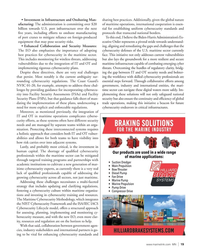 )
April 2024 - Marine News page: 19
)
April 2024 - Marine News page: 19best practices for cybersecurity in the maritime sector. face. This initiative not only addresses current vulnerabilities This includes monitoring for wireless threats, addressing but also lays the groundwork for a more resilient and secure vulnerabilities due to the integration of IT and OT and maritime
-
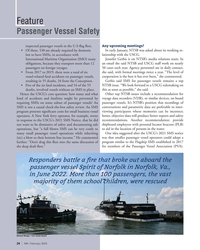 )
February 2024 - Marine News page: 24
)
February 2024 - Marine News page: 24Feature Passenger Vessel Safety Any upcoming meetings? inspected passenger vessels in the U.S-? ag ? eet. • Of these, 530 are already required by domestic In early January, NTSB was asked about its working re- law to have SMSs, in accordance with lationship with the USCG. International Maritime
-
 )
January 2024 - Marine Technology Reporter page: 18
)
January 2024 - Marine Technology Reporter page: 18TECH FEATURE WAVE POWER All images courtesy Mocean Energy MOCEAN ENERGY AIMS TO CREATE AN OFFSHORE RENEWABLE MICROGRID Garnering power from ocean waves is a generation behind the progress of offshore wind, but Mocean Energy, led by founder and managing director Cameron McNatt, is aiming to help offshore
-
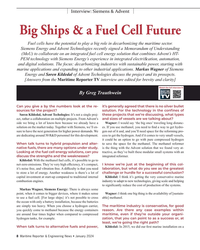 )
January 2024 - Maritime Reporter and Engineering News page: 8
)
January 2024 - Maritime Reporter and Engineering News page: 8Siemens Energy Big Ships & a Fuel Cell Future Fuel cells have the potential to play a big role in decarbonizing the maritime sector. Siemens Energy and Advent Technologies recently signed a Memorandum of Understanding (MoU) to collaborate on an integrated fuel cell energy solution that combines Advent’s
-
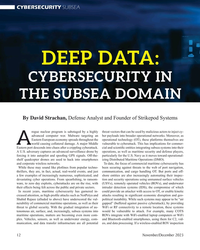 )
November 2023 - Marine Technology Reporter page: 12
)
November 2023 - Marine Technology Reporter page: 12Navy as it moves toward operational- shelf quadcopter drones are used to hack into smartphones izing Distributed Maritime Operations (DMO). and corporate wireless networks. To date, the focus of commercial maritime cybersecurity has While these may sound like plotlines from popular techno- been securing against
-
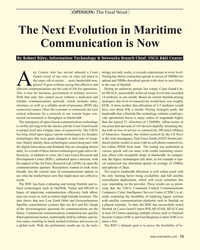 )
November 2023 - Maritime Reporter and Engineering News page: 73
)
November 2023 - Maritime Reporter and Engineering News page: 73OPINION: The Final Word The Next Evolution in Maritime Communication is Now By Robert Riley, Information Technology & Networks Branch Chief, USCG R&D Center ny Coastie who has served onboard a Coast nology not only works, it exceeds expectations at every level. Guard vessel of any size, or class can
-
 )
November 2023 - Maritime Reporter and Engineering News page: 70
)
November 2023 - Maritime Reporter and Engineering News page: 70In the Shipyard Latest Deliveries, Contracts and Designs Marcelle Melosira: Hybrid Research Vessel Derecktor Shipyards NY in Mamaroneck, N.Y. has deliv- tion with UVM and Chartwell, the 64-foot research catamaran ered a new hybrid research catamaran to the University of has been crafted to ful? ll the
-
 )
November 2023 - Maritime Reporter and Engineering News page: 31
)
November 2023 - Maritime Reporter and Engineering News page: 31WAVE DATA & SHIP DESIGN data gap ready to be drastically reduced through Bristlemouth, “By applying the ? rst open ocean connectivity standard. A collaboration be- accurate weather tween Sofar and strategic partners in the public and private sector, Bristlemouth delivers plug-and-play hardware inter- for
-
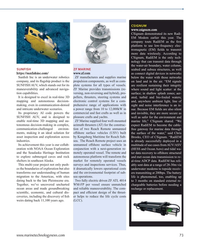 )
September 2023 - Marine Technology Reporter page: 73
)
September 2023 - Marine Technology Reporter page: 73Modem earlier this year. The company touts RadiEM as the ? rst platform to use low-frequency elec- tromagnetic (EM) ? elds to transmit more data wirelessly. According to CSignum, RadiEM is the only tech- nology that can transmit data through the water-air boundary, water column, SUNFISH ZF MARINE
-
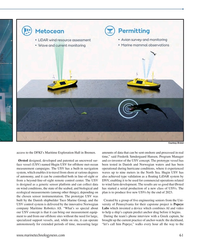 )
September 2023 - Marine Technology Reporter page: 61
)
September 2023 - Marine Technology Reporter page: 61Courtesy Ørsted access to the DFKI’s Maritime Exploration Hall in Bremen. amounts of data that can be sent onshore and processed in real time,” said Frederik Søndergaard Hansen, Program Manager Ørsted designed, developed and patented an uncrewed sur- and co-inventor of the USV concept. The prototype
-
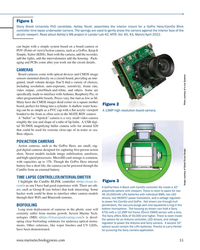 )
September 2023 - Marine Technology Reporter page: 55
)
September 2023 - Marine Technology Reporter page: 55Figure 1 Stony Brook University PhD candidate, Ashley Nicoll, assembles the interior mount for a GoPro Hero/CamDo Blink controller time lapse underwater camera. The springs are used to gently press the camera against the interior face of the acrylic viewport. Read about Ashley’s MS project in Lander Lab #2
-
 )
September 2023 - Marine Technology Reporter page: 50
)
September 2023 - Marine Technology Reporter page: 50MTR 100 Silicon Sensing www.siliconsensing.com Silicon Sensing Systems Ltd is a leader in silicon MEMS gyroscopes, accelerometers and inertial mea- surement systems, focusing on products delivering high performance, ultra-reliability with affordability. The com- pany has supplied more than 25 million
-
 )
September 2023 - Marine Technology Reporter page: 48
)
September 2023 - Marine Technology Reporter page: 48that can The new pro? ler provides survey-grade sensor technology, be compared to monitor temporal changes in seagrass cover- coupled with Bluetooth wireless technology, a rechargeable age for the planning of protection and regeneration projects battery and an integral GNSS module to geo-locate each pro
-
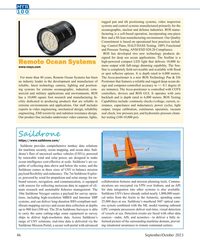 )
September 2023 - Marine Technology Reporter page: 46
)
September 2023 - Marine Technology Reporter page: 46MTR 100 rugged pan and tilt positioning systems, video inspection systems and control systems manufactured primarily for the oceanographic, nuclear and defense industries. ROS manu- facturing is a cell-based operation, incorporating one-piece ? ow and a SS lean manufacturing environment. Our Quality
-
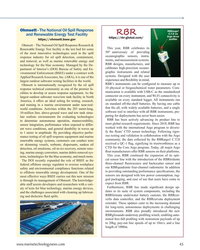 )
September 2023 - Marine Technology Reporter page: 45
)
September 2023 - Marine Technology Reporter page: 45Ohmsett - The National Oil Spill Response RBRargo³ C.T.D on RBR and Renewable Energy Test Facility Argo Arvor https://rbr-global.com/ pro? ler https://ohmsett.bsee.gov Ohmsett – The National Oil Spill Response Research & This year, RBR celebrates its Renewable Energy Test facility is the test
-
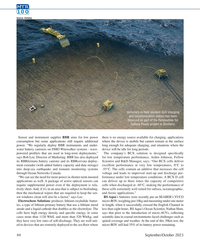 )
September 2023 - Marine Technology Reporter page: 44
)
September 2023 - Marine Technology Reporter page: 44MTR 100 Source: Verlume Verlume’s in-? eld resident AUV charging and communication station has been deployed as part of the Renewables for Subsea Power project in Scotland. Sensor and instrument supplier RBR aims for low power there is no energy source available for charging, applications consumption
-
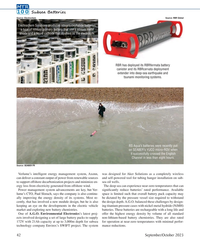 )
September 2023 - Marine Technology Reporter page: 42
)
September 2023 - Marine Technology Reporter page: 42in less than eight hours. Source: SEABER FR Verlume’s intelligent energy management system, Axonn, was designed for Aker Solutions as a completely wireless can deliver a constant output of power from renewable sources and self-powered tool for tubing hanger installation on sub- to support offshore decarboniz
-
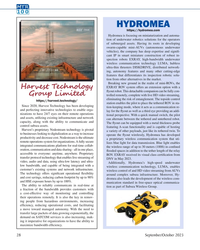 )
September 2023 - Marine Technology Reporter page: 28
)
September 2023 - Marine Technology Reporter page: 28, the company has deep expertise and signi? - cant IP in smart miniature construction of robust in- spection robots EXRAY, high-bandwidth underwater wireless communication technology LUMA, hubless ultra-thin thrusters DISKDRIVE, distributed network- ing, autonomy features and many other cutting-edge features
-
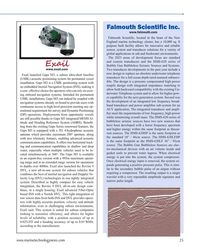 )
September 2023 - Marine Technology Reporter page: 25
)
September 2023 - Marine Technology Reporter page: 25Falmouth Scienti? c Inc. www.falmouth.com Falmouth Scienti? c, located in the heart of the New England marine technology cluster, has a 10,000 sq. ft purpose built facility allows for innovative and reliable sensor, system and transducer solutions for a variety of global applications in salt and
-
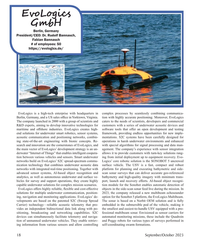 )
September 2023 - Marine Technology Reporter page: 18
)
September 2023 - Marine Technology Reporter page: 18EvoLogics GmbH Berlin, Germany President/CEO: Dr. Rudolf Bannasch, Fabian Bannasch # of employees: 50 https://evologics.de/ EvoLogics is a high-tech enterprise with headquarters in complex processes by seamlessly combining communica- Berlin, Germany, and a US sales of? ce in Yorktown, Virginia. tion
-
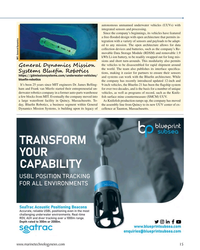 )
September 2023 - Marine Technology Reporter page: 15
)
September 2023 - Marine Technology Reporter page: 15autonomous unmanned underwater vehicles (UUVs) with integrated sensors and processing. Since the company’s beginnings, its vehicles have featured a free-? ooded design with open architecture that permits in- tegration with a variety of sensors and payloads to be adapt- ed to any mission. The open architect
